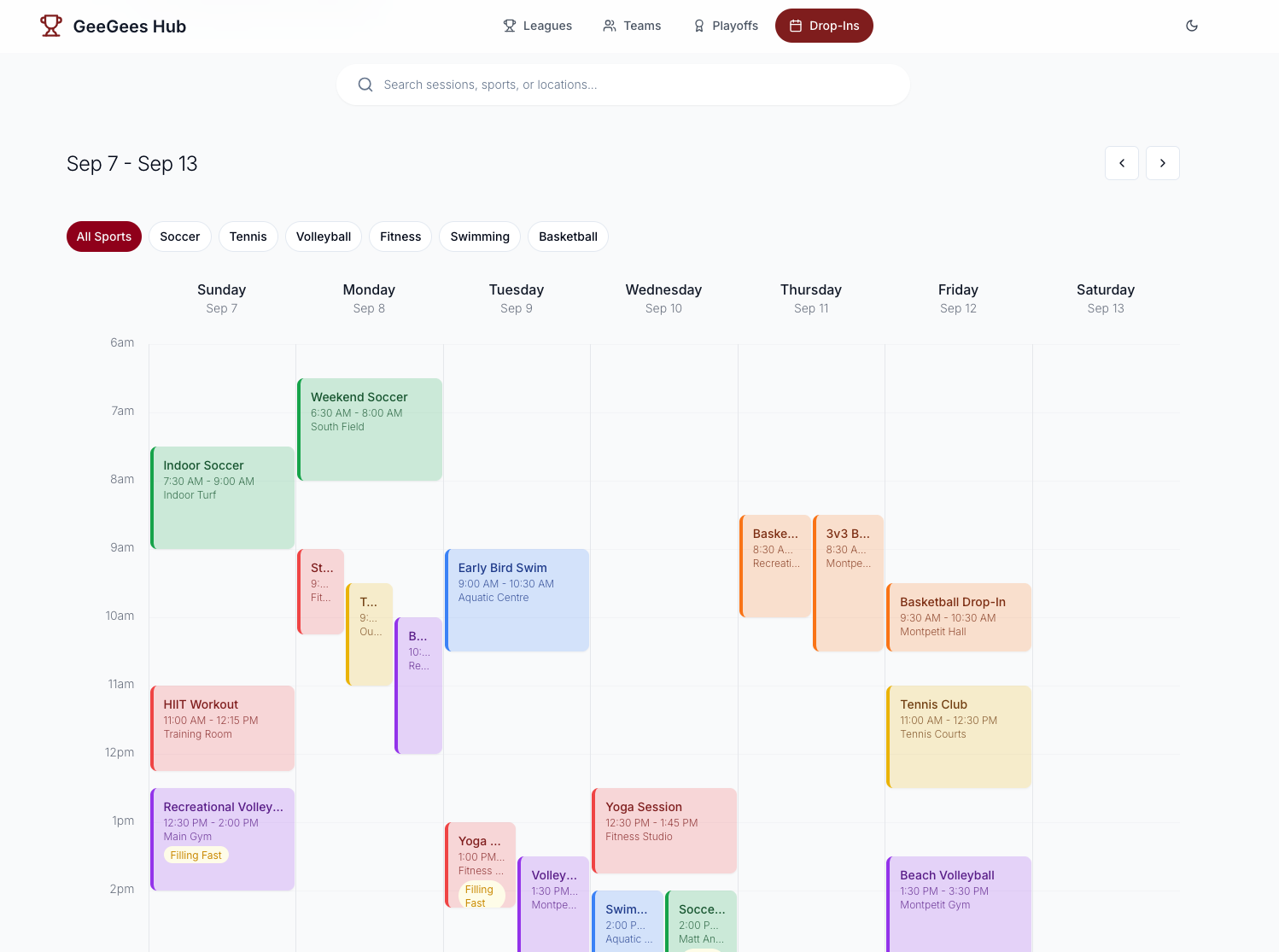GeeGees Sports Platform — One Project, Three Engines (and why I can’t stop building it)
uOttawa intramurals were chaos. I’m a player, a builder, and a shameless optimizer—so I turned my frustration into a platform.
I’m Youssef. I study CS at the University of Ottawa, work part‑time at the NRC, and play (a lot of) volleyball and basketball. Between classes, research, and games, I was constantly juggling five tabs, three spreadsheets, and “who’s subbing tonight?” texts. That pain turned into a project I’ve fallen in love with: an end‑to‑end, privacy‑respecting sports stack for students—scraper → API → web app—that makes intramurals feel as polished as pro sports.
This is the story of how those three pieces fit together, why I’m obsessed with the details, and what’s next.
TL;DR (what I actually built)
- GeeGees Hub (web) — Next.js + React + TypeScript UI with real‑time matchups, trending teams, playoff brackets, and an actually useful calendar.
- GeeGeesRec API (backend) — Rust + Actix Web + PostgreSQL serving standings, schedules, playoffs, and analytics in sub‑50ms.
- GeeGees Hub Scraper (ingest) — Playwright‑powered CLI with a beautiful TUI to turn messy registration sites into clean JSON.
- Philosophy — Fast, accessible, resilient, and fun to use. When the data source flakes, the product shouldn’t.
Why this matters to me
I live this data. I practice, I scout, I drag my friends to late games across campus. I also care about craft—clean APIs, accessible UI, and systems that don’t fall apart when a server hiccups. Building this wasn’t just a dev exercise; it made my campus life calmer and my teams better informed. It also scratched the builder itch: I love seeing a tight feedback loop between code and real‑world experience.
The architecture at a glance
ActiveNet & friends → Scraper (Playwright + TUI)
→ Clean JSON → GeeGeesRec API (Rust/Actix + SQLx/Postgres)
→ GeeGees Hub (Next.js 15 / React 19)
Ingest pulls structured data with respectful concurrency. API normalizes, indexes, and computes standings/trends. UI turns it into a fast, delightful experience with thoughtful loading, error states, and animations.
Ingest: the Scraper that respects your terminal
A lot of scrapers are throwaway scripts. Mine’s a proper CLI with a TUI: live progress bars, per‑task spinners, ETA, and clean error reporting. It prefers API endpoints over HTML for speed and stability, runs with concurrency limits, and outputs predictable hierarchical JSON (sport → league → team). It’s weirdly satisfying to watch.
Why I cared: ingestion quality sets the ceiling for everything else. If your ingest is flaky, your UI becomes a liar. I’d rather spend an extra week on a great pipeline than paper over bad data with UI tricks.
Core: the Rust API that doesn’t blink on game night
I rebuilt the backend in Rust (Actix Web + SQLx + Postgres) for a reason: sports are bursty. When a dozen games finish at once, you need realtime standings and playoff updates without timeouts.
Highlights:
- Sub‑50ms endpoints even under load, thanks to SQL‑first calculations (win %s, point diffs, bracket progression) and proper indexes.
- Environment‑aware CORS (lenient in dev, strict in prod) so shipping doesn’t become a build‑day panic.
- Zero‑downtime deploys; games don’t wait for maintenance windows.
Why I cared: I want fearless refactors and production confidence. Rust’s type system and SQLx’s compile‑time checks let me sleep before playoffs.
Experience: the Hub where students actually find stuff
The Next.js 15 + React 19 frontend is opinionated: quick, accessible, and visually coherent. I use server vs client components with intent, custom hooks for data fetching (SWR‑like), and a design system that keeps the app consistent.
Features students love:
- Featured matchups with live win‑probability rings and recent form.
- Trending teams driven by an Elo‑style momentum model—not just win streaks.
- Playoff brackets that update in real time.
- Drop‑in calendar that answers “where and when” without Slack archaeology.
Why I cared: this is for my friends and teammates. If the page stutters or a keyboard user gets stuck, I feel it personally.
Hard problems I had to earn
- Messy, changing data → robust fallbacks and idempotent updates so the app is never empty, just honest about state.
- State boundaries → server state (cached API data) vs client state (UI). Fewer re‑renders, more flow.
- Performance with motion → memoized charts and lazy‑loaded heavy components to keep the UI playful and fast.
What I learned (and keep applying)
- Rust for web is not just fast—it’s predictably fast. Ownership forces better designs.
- SQL belongs in the database. Let Postgres compute; ship smaller payloads.
- React maturity: error boundaries, transitions, and progressive enhancement are non‑negotiable.
- DX matters: a good CLI and clean contracts make future me (and future collaborators) faster.
Roadmap (the fun part)
Near‑term
- WebSockets for live scores
- Redis caching + rate limiting
- Team captain tools (rosters, comms)
- Better filters/search across sports & times
Mid‑term
- GraphQL endpoint + mobile SDK
- Analytics dashboard for players/leagues
- Referee portal & incident tracking
- Fantasy mode (because why not?)
Long‑term
- Multi‑university support
- Video highlights & alumni layer
- Smarter notifications and voice interfaces
Why I’m still excited
This project blends everything I care about: performance, accessibility, beautiful UIs, and making student life easier. It’s also mine—born from late games, long bus rides, and too many coffees. Every release makes campus sports feel a little more professional and a lot more human.
If you want to try it, contribute, or throw feature ideas at me, I’m all ears. See you on the court—and in the commit history.
